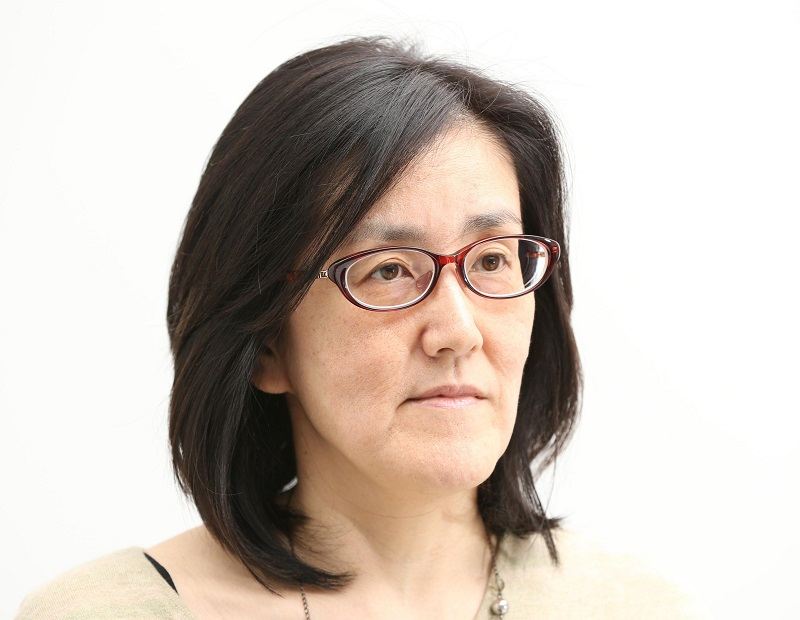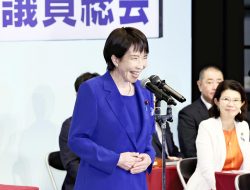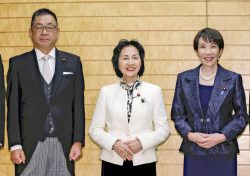Pension System Flaw Keeps Part-Timers’ Pay Low; Govt Urged to Address ‘Annual Income Barriers’

Part-time workers arrange products at a supermarket in Tokyo in September 2023.
8:00 JST, April 27, 2024
Against the backdrop of a labor shortage, this year’s shunto spring wage negotiations saw a greater rush of wage increases than in previous years. According to a tally as of April 16 by the Japanese Trade Union Confederation (Rengo), the weighted average of wage increases was 5.20% for regular employees and 6.08% for hourly part-time and other non-regular workers. Although the pay raise rate is higher for non-regular workers, their wages are still considerably lower than those for regular workers. It is crucial to continue to close the gap. In doing so, it will be important to eliminate the so-called “annual income barriers.”
Annual income barriers are income thresholds at which a part-time worker’s take-home pay paradoxically falls if their income rises beyond a certain level, after taxes and social insurance contributions are deducted. The main barriers are ¥1.03 million, beyond which every worker must pay income tax, ¥1.06 million, beyond which workers at relatively big companies must join employee’s pension and health insurance system, and ¥1.3 million, beyond which workers at other companies must join the government pension and health insurance system. Many part-time workers limit their own working hours to keep their income from exceeding the thresholds.
The recent worsening of labor shortages has prompted business owners to raise hourly wages to attract more workers and encourage them to work more hours. But higher pay causes workers to reach the annual income barriers more quickly, which in turn has led to an increase in the number of workers who reduce their working hours, resulting in further labor shortages.
The interesting thing here is that those who make such work adjustments are almost exclusively married women, according to economist Ayako Kondo, a professor at the University of Tokyo. Kondo and another economist analyzed tax data from 16 municipalities for five years from 2018 to 2022 and found that the distribution of annual income for married women showed clear concentrations just under ¥1.03 million and ¥1.3 million. The phenomenon was less pronounced for unmarried women. It was nonexistent for married men.
Why do married women behave this way? One reason is that Japan’s national pension system categorizes insured persons in an unusual way.
There are three types of insured persons in the system: Category II insured persons are full-time company employees or civil servants, Category III insured persons are dependent spouses of Category II insured persons and Category I is for those who don’t fit either category, such as a self-employed worker or a freelancer.
Under the system, a Category III person is covered by their spouse’s corporate health insurance and pension system, becoming entitled to their own pension benefit in old age even without having to pay a contribution themselves.
It is noteworthy that the spouse of a Category I insured person cannot become a Category III insured person.
According to Health, Labor and Welfare Ministry statistics, there were 7.21 million Category III insured persons, 98% of whom are women, as of the end of fiscal 2022. The contributions that should have been paid by the Category III insured persons are shouldered by the entire employee pension systems, including contributions of single men and women, the ministry explains.
When this system was introduced in 1986, it was common for women to quit their jobs to become housewives after marrying or having children. Many of them started working again as part-timers to supplement the family income once their children were old enough to go to school. Housewives of salaried workers were not subject to mandatory enrollment in the national pension system at that time, so their lack of old-age pension coverage in the event of divorce was a problem.
The most rational solution at that time would have been for the government to make it compulsory for housewives to pay contributions and join the pension system. However, in consideration of the fact that they were covered by their husbands’ health insurance without having to pay contributions of their own, the government decided to introduce a similar scheme for the pension system — the Category III insured person.
“The biggest problem with this system is that it discriminates against women based on whether or not they are married,” Kondo said.
This issue has been discussed many times in the government’s subcommittee for pension systems over the years, but no fundamental revision has been made. Some members of the subcommittee insist the Category III system is important for guaranteeing pensions to those involved in domestic care work, such as child-rearing and housework. But if so, why are spouses of self-employed workers or single mothers, who are also raising children and doing household chores, not exempt from paying contributions?
“The second problem is that the existence of married women who do not want a wage increase makes it difficult to raise wages for non-regular employees as a whole,” Kondo said.
Her words reminded me of a woman I interviewed several years ago, who was in her 50s and was living alone in western Japan after divorcing her abusive husband. Due to her age and lack of professional experience, she could not find regular employment and worked as a part-time telephone operator. She complained that her monthly income rarely exceeded ¥100,000, which was around the relative poverty line. She was barely getting by, and if she had children, it would have been even more difficult to make ends meet with that income. In Japan, although 86% of single mothers work, 39% of them are non-regular workers, making ¥2.72 million on average annually, or just one-third of the average annual income of households with children.
In recent years, however, societal norms have changed dramatically. The number of households with full-time housewives has been decreasing and the number of women who continue to work after having children without quitting their jobs has increased.
The business community also started to ask the government to solve the problem of annual income barriers. The ministry last October introduced new subsidies and other measures for companies to encourage employees to work beyond the income thresholds and be enrolled in the social security system. These measures, aside from being criticized as further spreading unfairness, are only temporary and will be available for a maximum of three years.
With over 7 million people insured under Category III, it will not be easy to change the system right away. And it should not be overlooked that the system makes it easier for women to choose a life of traditional gender roles, with men mainly working outside the home and women mainly doing housework and childcare at home.
The social security system should be neutral as to the way people work and live in the first place. To make the most of the current opportunity to increase wages, the government and politicians should work toward revising the very system that reinforces inequality.
Political Pulse appears every Saturday.

Ikuko Higuchi
Ikuko Higuchi is a senior research fellow at Yomiuri Research Institute.
"Editorial & Columns" POPULAR ARTICLE
-

Violations of Subcontract Law: Major Automakers Must Eliminate Old Practices
-

Local Governments’ Tax Revenues: Devise Ways to Correct Imbalances in Tax Sources
-

5 Japanese Business Dinner Mistakes to Avoid — and What They Taught Me About Business in Japan
-

Heavy Rains in Asia: Support for Victims, Flood-Control Measures Urgently Needed
-

Rice Coupons: A Misguided Approach to Countering Rising Prices
JN ACCESS RANKING
-

Keidanren Chairman Yoshinobu Tsutsui Visits Kashiwazaki-Kariwa Nuclear Power Plant; Inspects New Emergency Safety System
-

Imports of Rare Earths from China Facing Delays, May Be Caused by Deterioration of Japan-China Relations
-

University of Tokyo Professor Discusses Japanese Economic Security in Interview Ahead of Forum
-

Japan Pulls out of Vietnam Nuclear Project, Complicating Hanoi’s Power Plans
-

Govt Aims to Expand NISA Program Lineup, Abolish Age Restriction
























